Welcome to our forum. A Message To Our New and Prospective Members . Check out our Forum Rules. Lets keep this forum an enjoyable place to visit.
Currently working on errors from the latest (SimplePress) forum update. Many issues have been resoled and others are being worked on. Thank you for your patience.
 Topic RSS
Topic RSS



 (13 votes)
(13 votes) Member
Yes I think it most likely is Poirson. As to which one, it depends on the date. I now see 1836 and 1896 at the same time. Now, for me, its like looking at one of those optical illusions where I see a duck and a rabbit at the same time.
As they say: "It doesn't matter what you are looking at, its what you see. And we see with our brains through our eyes."
So how to settle on a date fro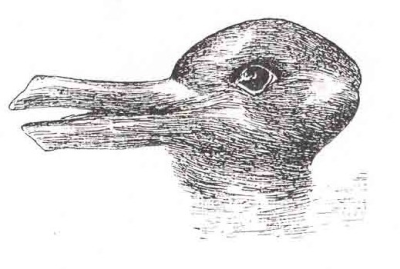

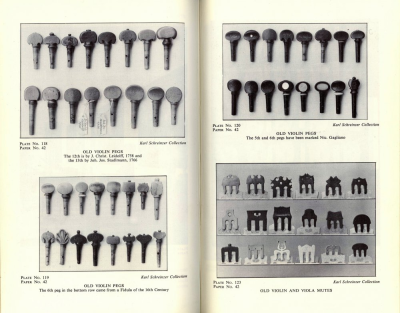
 m that pencil writing?
m that pencil writing?
If it says 1836 then the violin could be said to be possible made by Pierre Poirson 1732-1742 (a "fair maker") who worked in Mirecourt. But does the violin look that old? I'm not experienced enough to have a clue. But the pegs could well be original 18th century ones because they are old and they are Baroque.
If the writing says 1896 then it could be a Elophe Poirson violin. Then what of the old boxwood baroque pegs?
Regulars
 Offline
Offline





The pegs don't mean a lot - you could probably buy a big box of job lots and odds and ends then as now in auctions (our orchestra's first violist would often report buying "a box of 20 assorted chin rests" and such like). Maybe when ebony came into fashion, lots of boxwood stuff was offloaded cheap and ended up filling drawers in pro/amateur repair shops.
I have no idea about the date inside, hence "I half wondered". My teacher's viola is 18th century, but it's by a top maker, and I haven't had a close look at it, as shoulder rest and chinrest are customised for her. Like furniture that age, a well-looked-after instrument doesn't look old. Strads probably don't - I've never seen one up close, though. But I keep meaning to go back to the V&A to look at their instruments - I haven't been for more than 30 years. Or the Horniman museum has a collection of instruments. Haven't been there for 10 years.
A clue might be the use of the branding iron - the earliest dates may be known and useful. I'll ask on vcom.
Andrew
Verified human - the ignominy!
Member
Did they actually "brand" the violins with a hot iron, or were the letters scribed-in and then blackened?
What I don't understand is the "liver spot" marks on the face of the violin. The violin has cleaned up with just a tiny amount of water with a minute fraction of rice vinegar added, but those spots won't budge a single bit. They have impregnated the varnish. My daughter's teacher had a lovely sounding old Italian violin on trial from a renowned violin dealer some years ago. It had the same marks on it.
Regulars
 Offline
Offline





Regulars
 Offline
Offline





Member
Gordon Shumway said
Something that is intriguing is, given how much wear the fingerboard has suffered, why is there no wear where the bridge has been?If you hunt around, you'll find examples of this in extremis.
I am wondering if the table (face of the violin) is just possibly a later replacement addition. Could it just possibly be a cut and shut violin? The varnish on the back appears definitely more autumn leaf yellowy than that on the table, which under certain lighting conditions appears more yellowy-golden-amber. The varnish is intriguing. On this one there is no way I can tell if its oil or spirit varnish.
Regulars
 Offline
Offline








@MikeSutton -
I'm sure the spots were caused by something organic, but can't but my finger on it - not in clusters, and mildew remains only on the surface, unlike mold...
Have heard many things like to eat linseed oil, but suppose anything possible if some type of natural oil was used in the finish.
Wish I could remember where I've seen spots like on your violin before. Personally, think it's cool & adds character - you shouldn't try to remove them.
Regulars
 Offline
Offline





MikeSutton said
Gordon Shumway said
Something that is intriguing is, given how much wear the fingerboard has suffered, why is there no wear where the bridge has been?
If you hunt around, you'll find examples of this in extremis.
I am wondering if the table (face of the violin) is just possibly a later replacement addition. Could it just possibly be a cut and shut violin? The varnish on the back appears definitely more autumn leaf yellowy than that on the table, which under certain lighting conditions appears more yellowy-golden-amber. The varnish is intriguing. On this one there is no way I can tell if its oil or spirit varnish.
Probably it should have been the first thing to hit us, but the back and the top must come from two different violins. Or more likely the top is original on grounds of size and shape?
The back must be a late 19th century Poirson, bog-standard and original in appearence. Maybe it began life as an anonymous white, bottom-rung violin destined to be a Breton type then Poirson branded it his own. (If you want to believe it's an 18th century Poirson, I'll leave verification of that to you. That it's clearly a Breton type is strong evidence against that, I'd guess)
Maybe there are no bridge marks because the top got sanded at some stage and then varnished badly with the wrong colour varnish. Maybe the top got a pot of hot glue or acetone spilt on it and the two halves separated etc.
Andrew
Verified human - the ignominy!
Regulars
 Offline
Offline





Incidentally, anyone with a spare £250 burning a hole in their pockets can buy a copy of this
Andrew
Verified human - the ignominy!
Regulars
 Offline
Offline





Member
On closer inspection it looks like the amber varnish has been mostly rubbed off the back and a less of the ribs, leaving the yellow base coat on most with some amber at the edges. The top might have been re varnished a long time ago I suppose.
I certainly don't "believe" it is an 18th century violin. Only that all possibilities should be weighed in the case of this one so they can be rejected or accepted on all the evidence.
There is very little flaming on the one piece back. In fact, for all the world on the outside it looks like a one piece back. But from close inspection on the inside (now the top is off) its most definitely a two-piece back. I've never seen one so well fitted together before. But that is because to date I've only worked on factory violins.
Member
Gordon Shumway said
Incidentally, anyone with a spare £250 burning a hole in their pockets can buy a copy of this
The back could be a late 19th century addition only if (a) the pencil writing reads 1896 and not 1836, or (b) it was never an honest note in the first place. Do either of those conclusions seem likely?
Member
ELCBK said
@MikeSutton -I'm sure the spots were caused by something organic, but can't but my finger on it - not in clusters, and mildew remains only on the surface, unlike mold...
Have heard many things like to eat linseed oil, but suppose anything possible if some type of natural oil was used in the finish.
Wish I could remember where I've seen spots like on your violin before. Personally, think it's cool & adds character - you shouldn't try to remove them.
Many thanks.
I think if I tried to remove them any further than the gentle very slightly damp (water with tiny trace of rice vinegar added) wiping with a soft cloth that I have done so far would result in varnish removal, which I definitely won't do.
My hands have the same "character" from too many days spent boat (fly) fishing in the sun. A little orange fake tan an I'l match the violin.
Regulars
 Offline
Offline





MikeSutton said
Gordon Shumway said
Incidentally, anyone with a spare £250 burning a hole in their pockets can buy a copy of this
The back could be a late 19th century addition only if (a) the pencil writing reads 1896 and not 1836, or (b) it was never an honest note in the first place. Do either of those conclusions seem likely?
Or it could be biographical, as I said - some repairer may have had the back off, thought it might be a Breton and written his name (wrongly spelt) and date of death inside. We'll never know.
Or it could have been written on the plank before it became a violin. You'll have to make your own mind up - we can't really see enough in photos - to me the inside surface of the back looks flat, whereas I thought violins had curved interiors? No idea.
Pencil is meaningless. Even labels are meaningless. I could open mine and write 1829 inside.
Andrew
Verified human - the ignominy!
Member
If written on the wood prior to making the violin then it would have been written on the two matched halves at that time. Because, as said it is actually a two pierce back. You are right that the back is flat. But it is flat only in the bottom 1/4. The inside of the back is pretty much normally curved in the belly section (middle) and top nearer the neck. But it is certainly rather flat in the last 1/4 near the end-pin. Which I've not seen before. I've no idea if it is common. It's flat on the inside and outside in that bottom 1/4.
Date says Dec 10th and looks like 1836 (but could be 96). So if that is the date of the death of the supposed maker (biographical note), rather than date of being made or repaired Dec 10 might be relevant.
Member
The mystery violin is finally back together in one piece.
What I never realised is that it is a genuine baroque violin. The fingerboard being a fair bit shorter and the back being noticeably flatter and other proportions different to a Strad model. At some point in time someone added a small wedge under the fingerboard to elevate it closer to a Strad. model. But the neck is genuine and there is no graft.
If it is a Poirson violin, then taking account of the old pencil writing inside of 1836 - and working on the premise that the pencil writing is repairer's signature - then it could be a Pierre Poirson (1732-1742) violin. It can't be an Elophie Poirson violin, because that maker only made violins between 1876 and 1918.
The fact is is a genuine baroque (or late 18th early 19th transitional?) violin points me initially towards Pierre Poirson. But that is just an initial start. I could be completely wrong.
I tried the violin with Dominant strings and a modern tailpiece and a normal bridge (Aubert) but it was very unresponsive on the D string. I had to really tune the bridge to get anything like a good tone. So I tried a baroque bridge, Dominant strings and longer vintage late baroque length tailpiece. It sounds fantastic - I tuned it first to the classic Baroque 415 Hz and then tried it at the modern standard 420 Hz. Both sound great but I have tuned it now to 420. I added an interesting minimal antique chinrest (baroque violin players don't tend to use a chinrest) that works very well. I place a handkerchief over it to protect the instrument's varnish from my chin when playing.
The violin is incredibly sweet, colourful mellow and has good volume and brightness on the A string. Beautiful soulfulness and resonance on the D string. I set the bridge at 4mm on the E-string to 5mm on the G string.
Now I will have it played and assessed by a professional violinist.


 Log In
Log In Register
Register









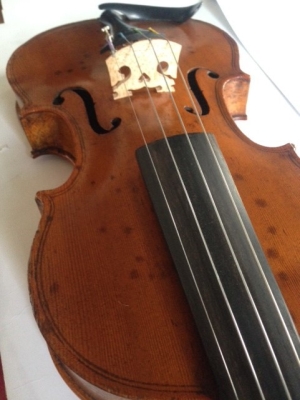
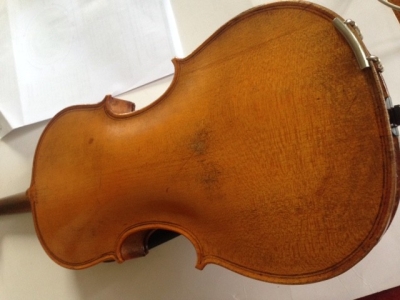
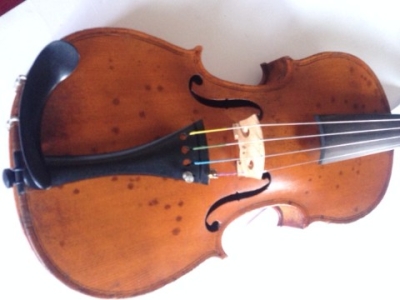
 Online
Online




